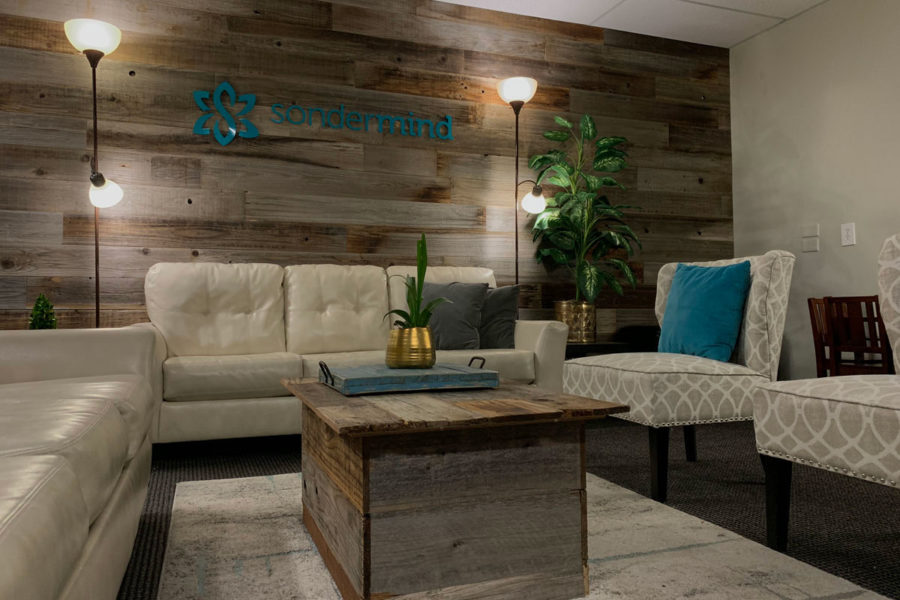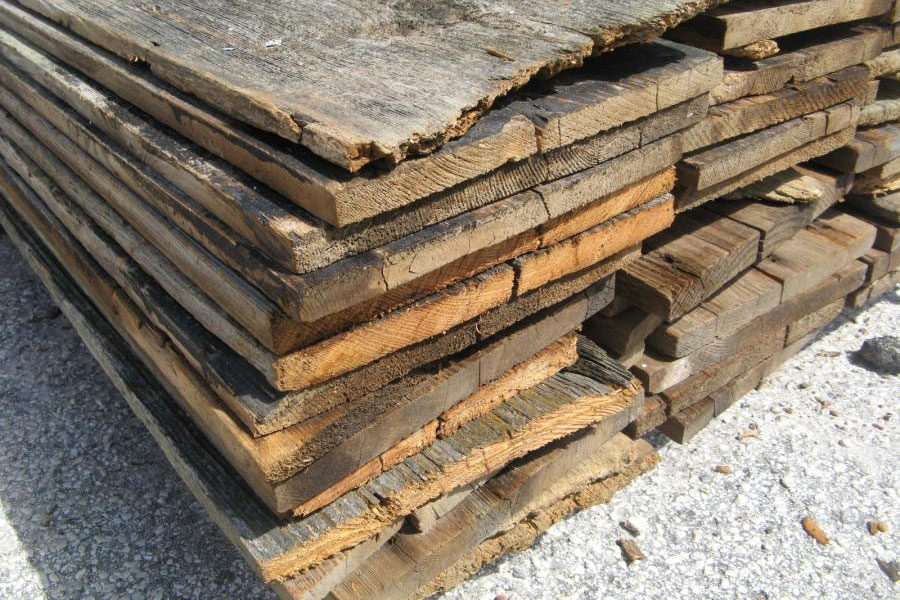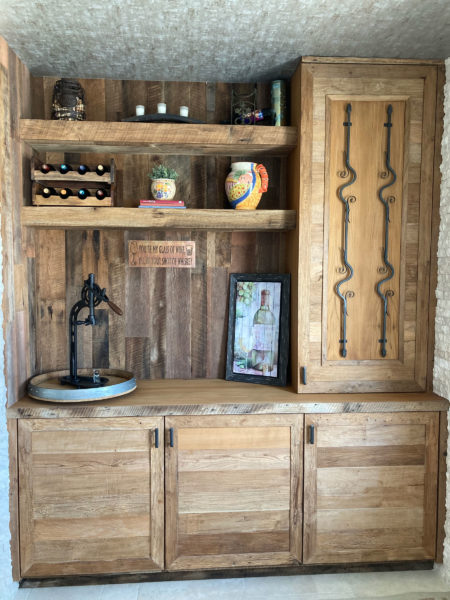Wood is a major construction material that is both renewable and sustainable. Using reclaimed wood in green building design, be it residential or commercial, allows us to use wood resources efficiently.
Green building aims to preserve natural resources while improving the quality of indoor life. Reclaimed wood reduces the demand for harvesting new timber and minimizes deforestation. Proper forest stewardship is essential to ensure trees grow for years to come.
Let’s take a look into how using reclaimed lumber from 100-year-old structures to build new, green structures is the ultimate form of upcycling.
- Indoor reclaimed wood accent wall and table by Woodstock Architectural Products. Photo courtesy of Woodstock Architectural Products
How Does Reclaimed Wood Reduce Waste?
Recycling or upcycling in any way reduces waste. Reducing landfill waste is a major benefit of recycling wood. According to the EPA, wood makes up 8.3% of all landfill waste, which totaled 12.2 million tons in 2018. Reclaimed wood in building construction and design continues to rise as the architectural community acknowledges its many benefits. Sustainable designs incorporating reclaimed wood curbs the use of hazardous and/or dangerous equipment needed to cut new lumber.
Reclaimed wood is not all the same. Reclaimed wood planks for construction are typically more durable planks that can withstand certain conditions. Do-it-yourself reclaimed wood panels are milled into thinner planks with standard widths. Milling creates waste by stripping planks down to size.
Unfinished reclaimed wood comes with risks. Unfinished planks must be metal-free (de-nailed), bug-free, and quality-controlled to remove any warping, splitting, or decomposing boards. Finishing the planks helps the wood be more equipped to handle changing environments, and adaptability is crucial for a green design.
Is Reclaimed Wood Energy-Efficient?
Building green will continue to rise because it’s good for all—good for the economy and good for the environment, too. The typical life cycle of harvesting new lumber for use in construction includes growth, harvest, transport, manufacture, and construction itself. The wood harvesting process alone requires less energy consumption and fewer fossil fuels needed to produce other materials such as steel or concrete.
Reclaimed wood is significantly more energy-efficient because the growth, harvest, and processing (kiln drying) life cycle phases are not as long as newly harvested wood. In some cases the transport stage is eliminated because most reclaimed wood is sourced locally.
Most importantly, keep in mind that reclaimed wood has no national industry standards. Although it has many benefits, purchasing from a reputable manufacturer can put you at ease knowing you’re receiving a high-quality finished product.
- Decades-old barn sourced for reclaimed barn wood by Woodstock Walls. Photo courtesy of Woodstock Architectural Products
Is Reclaimed Wood Safe?
Wood reclaimed from waterways, ships, railroads, old pallets, old homes, or wine barrels run the risk of carrying toxic chemicals. Wood that has been underwater or wet for an extended period may have remnants of mold spores. Shipping pallets may have been sprayed with protectant chemicals that are potentially toxic or toxic pesticides to keep bugs away. Authentic American reclaimed barn wood is the safest choice—even safer is to see the wood yourself.
That’s why reputable manufacturers source century-old barn wood and examine the structures themselves. For example, at Woodstock Walls, the owner takes trips through the back countries of southern and Midwest states to find the highest quality reclaimed wood free from decomposition, bugs, and mold. The odds of these 100-year-old barns being exposed to toxic chemicals is low because the barns have not been used in decades, though there is a chance of bacteria residue being left behind from barns that held farm animals. Selecting wood from higher up on the structure minimizes that risk as well.
- Raw and unfinished authentic reclaimed barn wood planks. Photo courtesy of Woodstock Architectural Products
How Does Reclaimed Wood Improve Quality of Life?
Wood is a natural sponge. It can work as an insulator with air pockets in its cellular structure that help it slow the conductivity of heat. Wood also absorbs moisture adding to improved indoor air quality. Its ability to moderate humidity maintains balance with surrounding air, meaning it will alter humidity when the air is too dry or too moist. Breathing easy is a breeze when using reclaimed wood in the interior of buildings.
Reclaimed wood is not only for walls but also flooring, architectural panels, moulding, doors, countertops, tables, shelves, beams, and ceiling panels.
Compared to its construction material counterparts, wood emits up to 29% fewer greenhouse gases and releases up to 20% fewer pollutants into the air.
In addition to indoor air quality, reclaimed wood has numerous health benefits that improve the overall quality of life. Reclaimed wood reduces stress and creates a calmer environment than an indoor space without wood.
- Indoor reclaimed teak wood built-in cabinetry by Woodstock Architectural Products. Photo courtesy of Woodstock Architectural Products
Why Reclaimed Wood
Green buildings surpass the standards of a non-eco-friendly building with abstract designs. Being surrounded by the best natural material is a green living expectation. Reclaimed wood is all-natural, fragile material aged and weathered by mother nature over time. It has a highly appealing, unique look adding texture and depth to any room. Each reclaimed wood plank tells its own story and no two pieces look the same.
Reclaimed wood can also be of an exotic kind such as with Ancient Kauri wood, the oldest working wood in the world. 50,000-year-old Kauri wood rescued from the swamps of New Zealand is workable today. It has a beautiful reddish-brown color with gold flourishes within the grain.
Using reclaimed wood in commercial spaces compliments the simplistic metal interiors while making people feel better inside these spaces. At Woodstock Architectural Products we can manufacture anything with wood for homes and buildings. To ensure we are preserving our planet for the future, Woodstock AP is registered with the Forest Stewardship Council.








